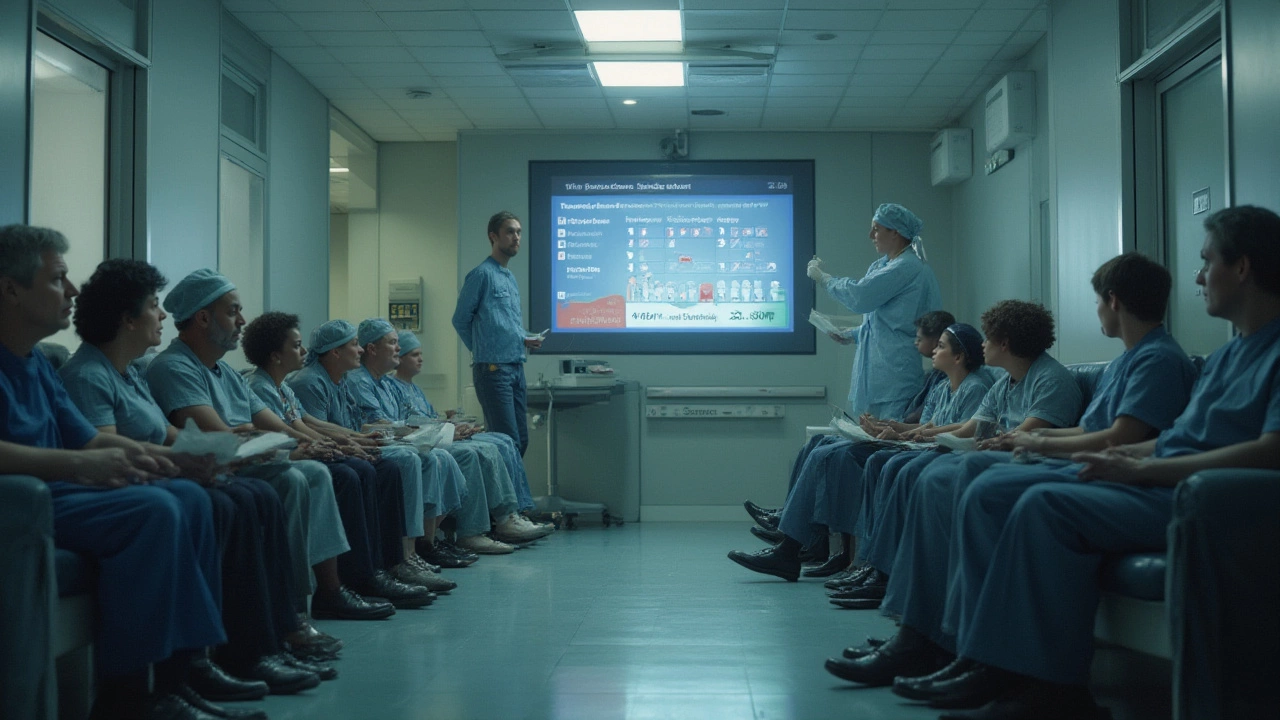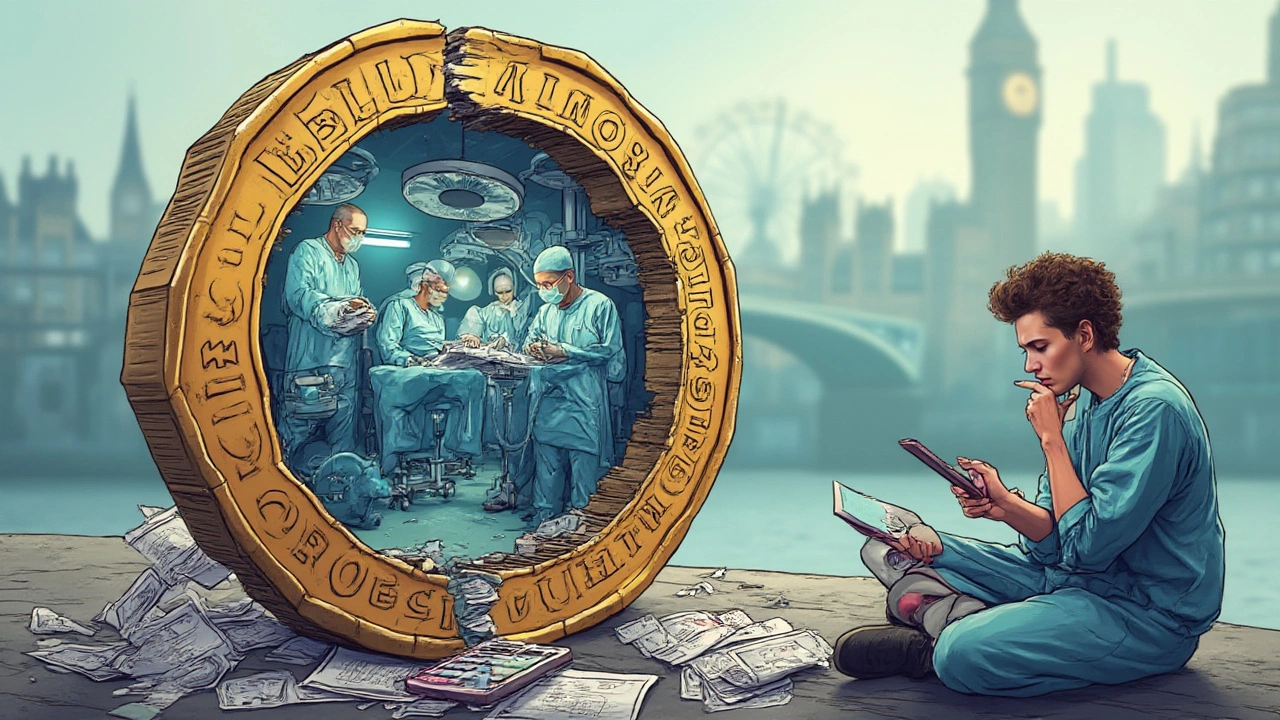 Jul, 15 2025
Jul, 15 2025
What would you do if your next medical bill read like the GDP of a small country? Most surgeries cost a lot, but some are so jaw-dropping you almost need oxygen after seeing the price. Big celebrities and regular people alike have been floored by surgical bills in the hundreds of thousands—and yes, sometimes over a million. It’s not all about fancy new tools or gold-plated scalpels, either. Some surgeries involve wild logistics, elite teams of doctors, and high-risk scenarios that pile on the price. Stick around—I’ll break down the world’s priciest surgeries, why they cost so much, and a few things I wish everyone knew before going under the knife (and under that mountain of bills, too).
What Makes a Surgery So Expensive?
You’d think the price tag is all about the surgeon’s fee or a fancy hospital suite. Think much bigger. The world’s most expensive surgeries are usually complicated, risky, and super resource-intensive. Take organ transplants. A heart transplant isn’t just a quick swap; it takes an army of specialists working round the clock, cutting-edge tech, surgical logistics that could rival a NASA launch, and sometimes, helicopters for donor organ retrieval. We’re talking big bucks at every step—imagine a line of people, all experts, each waiting to get paid for their part of a life-saving ballet.
It’s not just the complexity. Ever heard of a multi-organ transplant? Surgeons might replace your liver, intestine, pancreas, and even a kidney all in one go. It takes 12 hours, a surgical team that’s the stuff of medical legend, and the world’s best equipment. That bill usually lands well north of $1 million. Why? Operating room costs stack up by the minute, but so do intensive care monitoring, anti-rejection drugs, recovery, and years of follow-up.
The stakes get even higher with rare, experimental, or ultra-delicate surgeries. Facial transplants, for example, cost a fortune. It’s not even about vanity—these ops give burn or trauma victims a chance at normal function. But the donor matching, pre-operation planning, days-long surgery, and a lifetime of medications and therapies make celebrity cosmetic surgeries look like a bargain.
Location matters, too. Had that same surgery done in New York or London? You’ll pay far more than in India or Thailand—sometimes by a factor of ten. Insurance plays a wild card. Some countries’ national health systems cover almost everything; private patients elsewhere could face nightly ICU bills equal to a used car.
And here’s something a lot of people miss: sometimes the bill isn’t “just” about surgery. Think of a bone marrow transplant, often needed for cancer treatment. Post-op, you’ll need isolation and constant care for weeks, if not months, on top of the surgical work. Add in pricey anti-infection drugs, lab monitoring, and rehab, and suddenly, you’re staring at something close to $800,000. No one says that on the first hospital tour.
The Most Expensive Surgeries in the World
If you’re looking for the gold medal of pricey medical procedures, there’s stiff competition. Heart transplants are probably the best-known high-ticket item. In the United States, the total bill can easily top $1.5 million, a lot of that coming from pre-surgical assessments, finding a compatible donor, and ultra-complex aftercare. The surgery itself takes six to twelve hours. Then, weeks in a cardiac ICU, immune suppression drugs, and frequent biopsies for the rest of your life. There’s no easy exit from this financial gauntlet.
Liver transplants run a close second, ranging from about $800,000 to over a million dollars in major Western hospitals. Pediatric cases edge even higher, thanks to specialist fees and complex post-operative monitoring. Hospitals never quote one flat fee. They throw in hundreds of little charges, from each surgeon’s time to the disposable tools. Got a complication? There’s a four-figure charge right there.
Face and hand transplants almost don’t have a standard price—partly because they’re so new, and every case is unique. Cleveland Clinic did the first U.S. face transplant in 2008; the patient’s extended care and surgeries cost more than $1 million. Each year, a few of these operations happen worldwide. The price varies, but it’s always south of affordable for regular folks.
Then we get into pure medical marvels: separation surgeries for conjoined twins, especially those joined at the skull. These surgeries are custom masterpieces, often needing months of planning with virtual-reality mapping, custom-made prosthetics, and rehearsals with 3D-printed models. The real cost? Surgeons estimate $2.5 million is not unusual, and it doesn’t include the years of follow-up and rehabilitation that come after.
Bone marrow transplants, though not as glamorous, easily reach $800,000 (and up) for those without insurance. That’s because they require intense pre-op chemotherapy, months in protective isolation, and a cocktail of tricky medications. The kicker? Many insurance plans cover only a fraction of the cost. Same goes for lung transplants—after the initial $1 million sticker shock, lifelong preventive meds keep those costs climbing.
And if you thought your dental implants were pricey, try a full jaw reconstruction (mandibular reconstruction with prosthetics) after trauma or cancer. That surgery and follow-up can top $600,000. The materials are world-class (sometimes aerospace-grade), and the reconstructive team includes a small army: ENT surgeons, dentists, maxillofacial pros, and facial therapists. There's no booking it on a Black Friday sale.

Shock Factors: Why These Prices Seem Unreal
It’s easy to look at these numbers and think hospitals are out to buy themselves new swimming pools. But the wild part is just how many moving pieces get packed into those bills. The “surgery costs” you see online rarely include everything. There’s almost always a list of extras: anesthesiologist fees, scans, overnight stays, surgical equipment rentals, prosthetics, and loads of medicines. Try to break down just one line item for a heart transplant: you might see pharmacist costs, immunologist consults, and even special blood products. It’s a maze.
Some of it comes down to old-school logistics. For rare surgeries, like separating conjoined twins, hospitals often need to fly in global experts at short notice. Sometimes, multiple departments go into overdrive for days: radiology, neurology, orthopedics, haematology. Even smaller stuff like extra cleaning, security, and new machines adds up. With advanced robotics or 3D-printed prosthetics, every new tech step means more dollars on the patient’s tab.
Johns Hopkins, Cleveland Clinic, Mayo, and a few other centers have done the most high-profile, high-priced procedures. These aren’t surgeries you can just shop around for—there might only be a handful of surgeons in the world even willing to take them on. That makes the costs skyrocket. When you’re paying for the best, it’s like booking a personal space launch, not an Uber ride to the hospital.
Then, consider what happens when things don’t go exactly as planned. A post-op infection, a rejected organ, or bleeding complication turns large bills into stratospheric ones. Hospitals have to cover themselves for every risk. Lavish private rooms, personal ICU nurses, and extra security (which can happen for certain high-profile patients) all get added to the final sum.
Insurance comes in like a referee, knocking down some costs, but only if you have a top-shelf policy. If you’re a cash patient or out-of-network, buckle up. The United States is infamous for sending $200,000 out-of-pocket bills for surgeries most Europeans would get free or close to it. Some U.S. patients crowdfund for their operations; others travel to where the same operation costs a third as much, even with airfare and hotel thrown in.
It all sounds grim, but knowing where the money goes is actually empowering. When you understand the whole picture, you’re less likely to be blindsided by a 20-page itemized bill. It’s not just about what happens in the operating room; it’s what’s hidden behind the curtain.
Survival Tips: Navigating Sky-High Surgery Costs
If you’re reading this and sweating, you’re not alone. One rough truth? Most people don’t really know just how much even “everyday” surgeries can cost until they see the paperwork. Tooth extractions, knee replacements, even appendix removals have sent families scrambling before the first IV is even in. But for the most expensive surgery—the kind topped by heart and organ transplants—there’s a toolkit you can use to survive financially, and maybe emotionally, too.
First: knowledge is your shield. Always ask for an itemized up-front estimate if you can. Hospitals will look at you funny, but push hard. Insist on every line: surgery, anesthesia, post-op care, possible ICU time, and so on. If you’re dealing with private healthcare or are uninsured, this can help you spot weird or bogus charges and plan what’s actually coming.
Second: Shop around. No joke—costs of the same operation swing wildly from hospital to hospital, even inside the same city. If your problem isn’t an extreme emergency, calling hospitals or even going abroad (medical tourism is booming) can save you six figures. Example: a liver transplant in India, for top-tier private care, might run $45,000 to $65,000 instead of $800,000 in London or Los Angeles. You’ll want to research the reputation of the facility and aftercare plans before booking anything, but it’s real.
Third: Know your insurance, cold. Some policies have sneaky exclusions, out-of-network rules, or weird caps on key meds and rehab. Talk to both the insurer and the hospital billing team before surgery. You don’t want any ugly surprises. If you’re denied coverage for a life-saving op, look for medical advocates—some NGOs or legal aid outfits specialize in fighting these cases.
Fourth: Explore patient aid programs. Some hospitals, especially teaching or research centers, have grant funding for rare or life-threatening surgeries. Pharmaceutical companies sometimes subsidize anti-rejection or chemo meds. There are medical loan companies too—sites like MyMedicalLoan or CareCredit, though be wary about the interest rates.
Another hot tip: get your paperwork locked. Demand all pre-operation approvals in writing, and check every bill for double charges or weird “miscellaneous” fees. Don’t be afraid to negotiate. Some hospitals and private surgeons give big discounts to cash-paying patients or offer long-term payment plans if you ask. You can even get discounts for paying early or in cash up front—it never hurts to ask.
Want to go nuclear? Try crowdfunding. It sounds wild, but families who faced million-dollar surgery bills have raised life-saving amounts on GoFundMe or similar sites. Share your story (photos of your cat or dog don’t hurt—when I was sick, Charlie and Whiskers in my feed softened even the hardest hearts).
Above all, don’t go it alone. The biggest cost might not be money; it’s the stress, confusion, and dread that build up whenever big hospitals and bills collide. Lean on family, friends, patient support groups, or financial counselors. Even hospitals that seem cold and corporate often have social workers who can help you navigate the maze. You’re not just a number—you’re a person, and you deserve clarity, respect, and maybe a puppy cuddle at the end of a rough surgery day.
Surgery will always come with a price. But if you know the facts, prepare, and push back when needed, you can survive even the world’s most expensive medical emergencies with your wallet (and maybe your sanity) still mostly intact.
